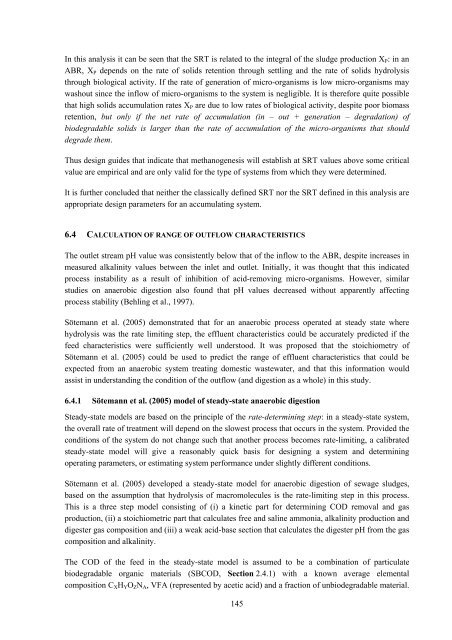analysis of a pilot-scale anaerobic baffled reactor treating domestic ...
analysis of a pilot-scale anaerobic baffled reactor treating domestic ...
analysis of a pilot-scale anaerobic baffled reactor treating domestic ...
Create successful ePaper yourself
Turn your PDF publications into a flip-book with our unique Google optimized e-Paper software.
In this <strong>analysis</strong> it can be seen that the SRT is related to the integral <strong>of</strong> the sludge production XP: in an<br />
ABR, XP depends on the rate <strong>of</strong> solids retention through settling and the rate <strong>of</strong> solids hydrolysis<br />
through biological activity. If the rate <strong>of</strong> generation <strong>of</strong> micro-organisms is low micro-organisms may<br />
washout since the inflow <strong>of</strong> micro-organisms to the system is negligible. It is therefore quite possible<br />
that high solids accumulation rates XP are due to low rates <strong>of</strong> biological activity, despite poor biomass<br />
retention, but only if the net rate <strong>of</strong> accumulation (in – out + generation – degradation) <strong>of</strong><br />
biodegradable solids is larger than the rate <strong>of</strong> accumulation <strong>of</strong> the micro-organisms that should<br />
degrade them.<br />
Thus design guides that indicate that methanogenesis will establish at SRT values above some critical<br />
value are empirical and are only valid for the type <strong>of</strong> systems from which they were determined.<br />
It is further concluded that neither the classically defined SRT nor the SRT defined in this <strong>analysis</strong> are<br />
appropriate design parameters for an accumulating system.<br />
6.4 CALCULATION OF RANGE OF OUTFLOW CHARACTERISTICS<br />
The outlet stream pH value was consistently below that <strong>of</strong> the inflow to the ABR, despite increases in<br />
measured alkalinity values between the inlet and outlet. Initially, it was thought that this indicated<br />
process instability as a result <strong>of</strong> inhibition <strong>of</strong> acid-removing micro-organisms. However, similar<br />
studies on <strong>anaerobic</strong> digestion also found that pH values decreased without apparently affecting<br />
process stability (Behling et al., 1997).<br />
Sötemann et al. (2005) demonstrated that for an <strong>anaerobic</strong> process operated at steady state where<br />
hydrolysis was the rate limiting step, the effluent characteristics could be accurately predicted if the<br />
feed characteristics were sufficiently well understood. It was proposed that the stoichiometry <strong>of</strong><br />
Sötemann et al. (2005) could be used to predict the range <strong>of</strong> effluent characteristics that could be<br />
expected from an <strong>anaerobic</strong> system <strong>treating</strong> <strong>domestic</strong> wastewater, and that this information would<br />
assist in understanding the condition <strong>of</strong> the outflow (and digestion as a whole) in this study.<br />
6.4.1 Sötemann et al. (2005) model <strong>of</strong> steady-state <strong>anaerobic</strong> digestion<br />
Steady-state models are based on the principle <strong>of</strong> the rate-determining step: in a steady-state system,<br />
the overall rate <strong>of</strong> treatment will depend on the slowest process that occurs in the system. Provided the<br />
conditions <strong>of</strong> the system do not change such that another process becomes rate-limiting, a calibrated<br />
steady-state model will give a reasonably quick basis for designing a system and determining<br />
operating parameters, or estimating system performance under slightly different conditions.<br />
Sötemann et al. (2005) developed a steady-state model for <strong>anaerobic</strong> digestion <strong>of</strong> sewage sludges,<br />
based on the assumption that hydrolysis <strong>of</strong> macromolecules is the rate-limiting step in this process.<br />
This is a three step model consisting <strong>of</strong> (i) a kinetic part for determining COD removal and gas<br />
production, (ii) a stoichiometric part that calculates free and saline ammonia, alkalinity production and<br />
digester gas composition and (iii) a weak acid-base section that calculates the digester pH from the gas<br />
composition and alkalinity.<br />
The COD <strong>of</strong> the feed in the steady-state model is assumed to be a combination <strong>of</strong> particulate<br />
biodegradable organic materials (SBCOD, Section 2.4.1) with a known average elemental<br />
composition CXHYOZNA, VFA (represented by acetic acid) and a fraction <strong>of</strong> unbiodegradable material.<br />
145
















